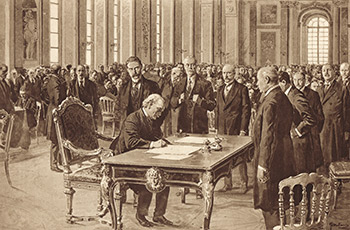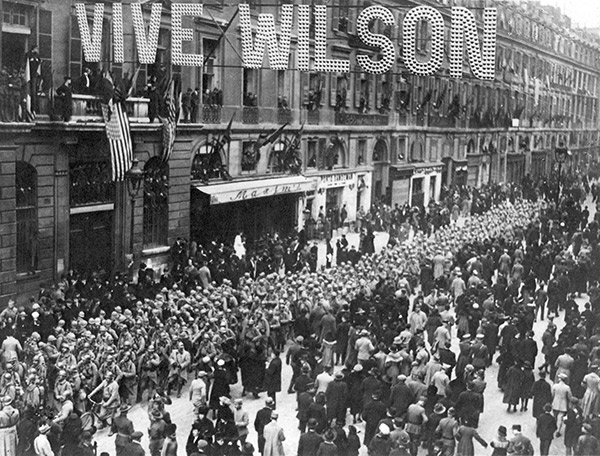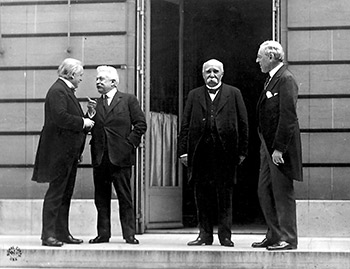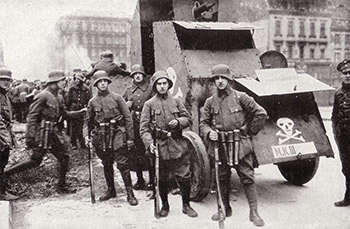The new world order, post-1918
Published in Features, Issue 6 (November/December 2018), Volume 26, World War IWhat sort of world did the ending of the First World War bring into being?
By John Horne
At 11am on 11 November 1918, the guns fell silent along the Western Front. The noise, continuous since late 1914, was said to have been the loudest ever made by humans. Now weary soldiers simply shook hands. It was enough to have survived when over ten million of their fellows had died. Rejoicing was left to the towns and cities of France, the British Empire and the USA, whose armies had pushed the Germans out of France over the previous three months. That same morning, Canadian soldiers reached Mons in Belgium, where the British had first seen action in August 1914. Three quarters of a million of them had died since then, however, including 35,000 Irishmen. While many Germans surrendered, enough were still conducting a fighting retreat to make an armistice (or cease-fire) welcome. Its terms allowed the allies to occupy the Rhineland, but they never reached Berlin. Had they really won?
The fighting had defied expectations. Rather than decisive battles, the war had become a siege on multiple fronts around Europe. Machine-guns and high-explosive artillery made infantry offensives costly until the end, and the struggle turned into one of attrition, wearing the enemy down. In the end the Allies gained the advantage. The Germans could not win but neither were they beaten openly in the field, allowing some to assert that the home front had betrayed them. The battlefield violence of the Great War was terrible, and would remain unsurpassed even by the Second World War.
What had it all been about?
The defeated Germans hoped to make peace on the basis of the Fourteen Points declared by President Woodrow Wilson in January 1918. These proposed a new order based on national sovereignty and a League of Nations to prevent wars. While the British and French leaders (Lloyd George and Clemenceau) wished to protect their own national interests, they also subscribed to the idea of the war as one for democracy and national self-determination in Europe and against the authoritarian military rule exercised by the Kaiser’s Germany and its allies over much of the continent.
The war had not started out like that. Triggered by a conflict between Serb nationalism and the multinational Austro-Hungarian empire, it had pitted the major European states against each other over the balance of power. It had turned into a struggle between entire societies to sustain the war of attrition, however, and the strain told most on those least able to bear it—the Russian, Austro-Hungarian and Ottoman empires.
By December 1917 the war had brought revolution to Russia and the Bolsheviks had taken that country out of the war. In 1918 revolution broke out in Ukraine, as Germany gained control of the country from Russia under the Treaty of Brest-Litovsk in March. Nationalists were demanding independence across eastern Europe and in Ireland. As Germany launched its final bid for victory before the American build-up overwhelmed it, conservative nationalists backed the military government in pursuit of a permanent hegemony over Europe, though German liberals and socialists resisted this.
Peacemaking

Above: British Prime Minister David Lloyd George signing the Treaty of Versailles on 28 June 1919. (Alamy)
The armistice on 11 November was preceded by those with Germany’s allies (Bulgaria, the Ottoman Empire, Austria-Hungary). Europe entered a strange twilight in which war was over but peace had not yet come. This could only happen when the Allies gathered in Paris under the presiding figure of Woodrow Wilson for a conference that would seek to remake the European and world orders. The Allies had to keep millions of men under arms until the treaty with Germany was signed at Versailles on 28 June 1919, the other treaties following down to mid-1920.
The mood that winter was pregnant with hopes and fears for the future. These were reflected in the adulation of President Wilson. As he arrived in France on 13 December aboard the USS George Washington, he was greeted not just by the Allied leaders but also by the acclamation of people across Europe (except Bolshevik Russia), from nationalists to labour activists. As already mentioned, even leaders in the defeated states hoped that the Fourteen Points might produce an acceptable peace.

‘Vive Wilson!’—a Parisian crowd awaits US President Woodrow Wilson. From his arrival in France on 13 December 1918 Wilson was greeted by the acclamation of people across Europe.
Inevitably, as the peace conference unfolded in Paris from January 1919 it was fraught with contradictions. Unlike in 1945, when the Allies imposed total surrender, this peace process initially assumed that there would be limited participation by the vanquished. As it turned out, they were excluded from the negotiations but were allowed to respond to the final conditions. Many Germans had believed as recently as the spring of 1918 that they were on the brink of victory. Now the Allied presumption of their total defeat and retroactive ‘guilt’ for the war seemed to them shocking and unacceptable.

Above: The ‘big four’—Lloyd George (UK), Orlando (Italy), Clemenceau (France) and Woodrow Wilson (USA)—at the peace conference in Paris, 27 May 1919. (Library of Congress)
In addition to trying to restore a balance of power in Europe (despite the continued strength of a demographically dominant Germany and the absence of Bolshevik Russia), the Allies at the peace conference (especially the ‘big three’, Britain, France and the USA) also had to bring some order to eastern Europe, where it proved anything but easy to apply Wilson’s ideal of self-determination by coherent nation-states. Many were new, and most experienced acute tension in establishing their borders. Irish statehood was excluded from the new dispensation (despite a Sinn Féin delegation in Paris) out of deference to Britain. As for the colonial world beyond Europe, Wilson’s ideas had not been meant to apply there. Frustrated nationalists from Korea and India to China and Egypt found inspiration in the clarion call of his idealism but failed to gain access to the peace conference (or even to make it to Paris). Their claims, like those of the Irish, were rejected. Paris produced dreams and disillusion in equal measure.
The wars after the war
While millions of people felt relief that the slaughter of the Great War was over, relative calm in the victorious countries contrasted with upheaval in the defeated. Already in 1918 the Bolshevik revolution had imploded in counter-revolution and civil war. As fear of Bolshevism swept conservative circles in Europe and America, the Allies intervened unsuccessfully in Russia in a bid to crush the menace. The demands for national sovereignty in eastern Europe and the Middle East as the Austro-Hungarian and Ottoman empires collapsed also exploded into violence and border wars as the successor nation-states fought to establish their existence. The question of frontiers entailed the equally thorny issue of minorities, since ethnicities (and religions) were particularly complex and interwoven in eastern Europe, the Balkans and Anatolia. Moreover, the western marches of the Russian Empire had been home to the largest concentration of Europe’s Jews for many centuries, and they now became a minority in all the new nations. Poland, Lithuania and Finland, amongst others, experienced ethnic violence, anti-Semitism, civil war and inter-state conflicts.
Revolution and counter-revolution swept Germany, Austria and Hungary, with dissatisfied nationalists and military officers forming paramilitary units (or Freikorps) to crush the radical workers’ movements and fight border wars. Something similar happened in Italy. Though a victor, it was felt by many (notably Mussolini and his new ‘fascists’) to have lost out in the peace. Meanwhile, in the Ottoman Empire, which the Allies had carved up into spheres of influence, the charismatic leader Kemal Attaturk fought a war to establish an independent Turkey. In parts of Europe and the Middle East (Ireland included) the violence of these extended conflicts did not really end until 1923.
Social change
The war of attrition had imposed deep social changes. Mobilising the economy meant creating war industries. Women who struggled to keep families going also took over the work of absent men in factories and on the land. Skilled workers who had been called up as soldiers in 1914 returned to produce munitions. They were inevitably resented as ‘shirkers’ by those still at the front. In France, men came from the colonies as soldiers and workers, while African-Americans arrived with the US army. For the first time ever, people ‘of colour’ arrived in Europe en masse. If the soldiers were appreciated, the workers (some of whom had relations with French women, inverting the colonial order) occasioned friction and even riots. Moreover, all the wartime societies hosted refugees displaced by the fighting, often provoking what we would now call ‘compassion fatigue.’
The war tested societies to the limit. Worsening conditions and class tensions were measured against sacrifice at the front. By 1918 strikes were widespread. This was especially true in Germany and Austria-Hungary, owing in part to the hardship of the Allied naval blockade. Sometimes protest took on a pacifist tone. Yet as the fate of nations and empires hung in the balance, the support of the home fronts remained vital.
Not for the first time, war acted as a catalyst of social change. As peace came, there was widespread demand for recognition of both the sacrifices and the grievances of wartime, whether through revolution (as in Germany) or by reform (in Britain and France). Women gained the vote in many countries, starting with Russia, where they voted for the constituent assembly in 1917 before the Bolsheviks abolished it. Female suffrage was usually linked to wider reform giving all men the vote in return for their military service, but it also reflected feminism and women’s role in the war. Workers (backed by growing trade unions) gained various reforms, including the eight-hour day.
Social reform marked the peace conference. Women’s societies and trade unions proved powerful lobbyists. The Treaty of Versailles contained the principle of equal pay and set up the International Labour Organisation to plan social reforms with the League of Nations. It is true that economic recession and a conservative political turn in many countries in the early 1920s dashed more radical plans, yet the link between warfare and welfare, so crucial after the Second World War, was visible at the end of the First.
The Bolshevik revolution in the east, even though it had failed to foment the world revolution that both Lenin and Trotsky considered indispensable to its survival, meant that the flame of revolution and class warfare illuminated much of the social unrest elsewhere in Europe, North America and the colonial world. Even if the prospect of world revolution receded, communist parties oriented to Moscow became a feature of most post-war societies, stoking the ideological conflict with the counter-revolutionaries. The clash between communism, fascism and a liberal democracy that with the Allied victory found itself temporarily in the ascendant was a direct product of the First World War and how it ended. Moreover, the new Communist (or Third) International formulated an alternative vision to that of Woodrow Wilson for the disaffected in the colonies. From 1920 Moscow proposed that the anti-colonial struggle was now one manifestation of the fight against ‘imperialism’ that would pave the way to the revolution. Both ideas, democratic self-determination and anti-imperialism, would shape decolonisation as it reached full flood after the Second World War.
Remembrance

Above: Freikorps in Berlin, 1919. As revolution and counter-revolution swept Germany, Austria and Hungary, dissatisfied nationalists and military officers formed such paramilitary units to crush the radical workers’ movements and fight border wars.
One major question as the war ended was perhaps more intangible. How would the soldiers’ sacrifice be remembered? When the men went home, they were often welcomed (even in Germany) by local ceremonies. France and Britain held victory parades in Paris and London in July 1919 to celebrate the Treaty of Versailles, and other Allied capitals followed suit.
Yet even the victors struggled to find the right date for an annual commemoration. Should it mark the date the war began or its most important battle? Finally, they opted for when it ended, which meant (except for Italy) 11 November. The meaning was therefore the human cost of the war and its military dead rather than any political message. Already a temporary cenotaph (empty tomb) had been at the heart of each victory parade. In London this became permanent, while Britain and France in 1920 buried an ‘unknown’ soldier to individualise the mass dead of the conflict, including the ‘missing’ whose bodies were never found. The minute’s silence at the very moment of the armistice completed a ritual that was more about mass mourning than triumphalism.
All this proved more problematic in the vanquished states, and especially Germany. There, as in Austria and Hungary, the war and its dead were commemorated in myriad ways, more often local than national. The politics of defeat remained deeply divisive. When the Nazis came to power, redeeming the soldiers’ sacrifice in the Great War meant overturning the legacy of Versailles. In June 1940 they held the victory parade on the Champs Elysées that the allies had never managed in Berlin.
Ian Kershaw has argued in his recent history of Europe in the first half of the twentieth century, To hell and back, that the aftermath of the First World War was, paradoxically, more violent than that of an even more violent Second World War. The paradox stems from the fact that when the guns fell silent on 11 November 1918 the Great War had unleashed far more in the way of violence and forces for change (good or evil) than it could possibly resolve. While there was no automatic path from the First to the Second World War (we cannot dismiss the real peacemaking that took place in the 1920s, between the conclusion of the ‘greater war’ in 1923 and the financial crash of 1929), in the end it took the Second to resolve much of the upheaval of the First.
John Horne is a historian and emeritus Fellow of Trinity College, Dublin, where he was Professor of Modern European History.
FURTHER READING
R. Gerwarth & J. Horne (eds), War in peace: paramilitary violence in Europe after the Great War (Oxford, 2012).
I. Kershaw, To hell and back: Europe, 1914–1949 (London, 2016).
M. Macmillan, Peacemakers: the Paris conference of 1919 and its attempt to end war (London, 2009).
















